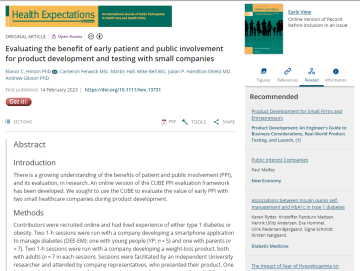Early involvement of public contributors can benefit product development in healthcare
- 21 February 2023
Involving public contributors at an early stage of product development might benefit companies trying to improve healthcare, according to research published in Health Expectations. Researchers from the Bristol BRC found not only that patients and public contributors could feasibly work with small healthcare companies but that they also felt valued and found the experience worthwhile.
Early engagement with public contributors means that the final design of a product is in a stronger position to meet user needs. This can happen because interacting with public contributors leads to knowledge sharing between technical experts, healthcare providers, other professionals and people who are experts in living with a particular condition.
During the study, researchers recruited contributors with lived experience of either type 1 diabetes or obesity. Participants were asked to take part in two sessions with a company developing a smartphone app to manage diabetes and two sessions with a company developing a weight-loss product. Contributors were then asked to evaluate their engagement with the sessions
Overall, contributors felt they were given the opportunity of sharing their opinions and believed their voices were being heard. They felt that both companies would be ready to make changes based on what had been discussed. Participants recognised that the products they were being consulted about would ultimately be expected to make a profit, however, the supportive attitude of the two companies resulted in most of them feeling comfortable about taking part in sessions.
Sessions were facilitated by a researcher and attended by company representatives who presented their product. Researchers then used the CUBE PPI framework to evaluate the value of early engagement with two small healthcare companies during product development.
CUBE framework
The CUBE framework assesses the value and quality of public involvement by allowing contributors to evaluate if they were given the opportunity to participate meaningfully. It also lets researchers gain insight into contributors’ experiences during PPI sessions and it can be used to compare PPI experiences across different organisations.
- The CUBE evaluation happens across four dimensions:
- Voice – the extent to which contributors feel they have a weak or strong voice in decision‐making
- Contribute – the number of ways to get involved to accommodate different contributors’ needs
- Agenda – the balance between organisation and public contributor concerns
- Change – the willingness or resistance to change by the organisation
Dr Ella Hinton, lead author, said:
“Companies tend to use market research, conducted in‐house or by external market research agencies, to garner public opinion about a specific product. This is just a passive way of getting information from the public through focus groups, individual interviews or surveys. By contrast, PPI encourages active involvement by patients and the public in a co‐design process.
“Mapping the evaluation of the four dimensions of the CUBE framework allowed us to carry out an in‐depth exploration of the views of our participants. There is no reason that companies could not benefit from the recommendations from this project to conduct their own ‘in-house’ PPI, as long as the balance of interests between public contributors and companies is maintained.”
Recommendations for PPI engagement
The study team suggest the following recommendations for PPI engagement:
- Ensure the company has clear goals for a PPI session before it takes place
- Consider which experts should take part in the session
- Ensure contributors understand how they are being asked to contribute by explaining this early on in the session
- Demonstrate and explain the CUBE questions before you ask contributors to answer them
- Prime the facilitator to ensure that all contributors can have their say during the session
- Complete the CUBE during the session to share the results (if time does not allow this part of the process, we suggest providing the CUBE link immediately after the session while contributors are keen to give their evaluation of the session)
- When interpreting the CUBE, consider that a higher score on a dimension may not be a better score
- Share the impact and outcomes of a session
- Use the evaluation by contributors to improve how future sessions are organised and run
